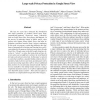143
click to vote
ICCV
2009
IEEE
14 years 10 months ago
2009
IEEE
We describe a solution to the challenging problem of estimating human body shape from a single photograph or painting. Our approach computes shape and pose parameters of a 3D huma...
154
Voted
ICCV
2009
IEEE
14 years 10 months ago
2009
IEEE
Recognizing human action in non-instrumented video is a challenging task not only because of the variability produced by general scene factors like illumination, background, occlu...
110
Voted
ICCV
2009
IEEE
14 years 10 months ago
2009
IEEE
This paper presents an approach to unsupervised segmentation of moving and static objects occurring in a video. Objects are, in general, spatially cohesive and characterized by lo...
130
Voted
ICCV
2009
IEEE
14 years 10 months ago
2009
IEEE
Hybrid generative-discriminative techniques and, in particular, generative score-space classification methods have proven to be valuable approaches in tackling difficult object or...
119
click to vote
ICCV
2009
IEEE
14 years 10 months ago
2009
IEEE
Finding the largest consensus set is one of the key ideas used by the original RANSAC for removing outliers in robust-estimation. However, because of its random and non-determinis...
126
click to vote
ICCV
2009
IEEE
14 years 10 months ago
2009
IEEE
In the context of variational image segmentation, we propose a new finite-dimensional implicit surface representation. The key idea is to span a subset of implicit functions with ...
157
click to vote
ICCV
2009
IEEE
14 years 10 months ago
2009
IEEE
Non-frontal view facial expression recognition is important in many scenarios where the frontal view face images may not be available. However, few work on this issue has been don...
125
click to vote
ICCV
2009
IEEE
14 years 10 months ago
2009
IEEE
One important problem in computer vision is to provide a demographic description a person from an image. In practice, many of the state-of-the-art methods use only an analysis of ...
120
Voted
ICCV
2009
IEEE
14 years 10 months ago
2009
IEEE
The varying object appearance and unlabeled data from new frames are always the challenging problem in object tracking. Recently machine learning methods are widely applied to tra...





